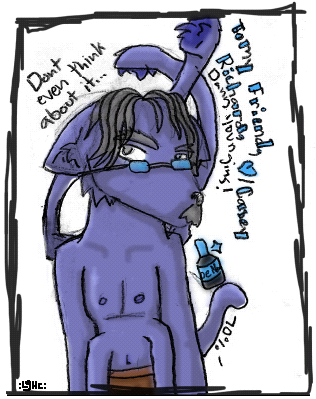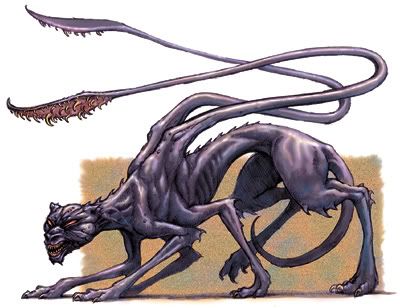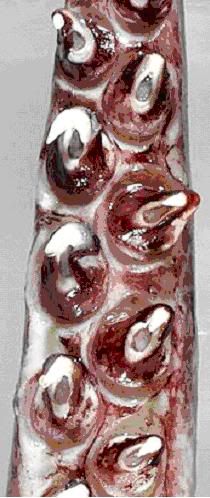From Wikipedia, the free encyclopedia
Jump to: navigation, search
For other uses, see Jaguar (disambiguation).
?Jaguar
Conservation status: Near threatened[1]
Scientific classification
Kingdom: Animalia
Phylum: Chordata
Class: Mammalia
Order: Carnivora
Family: Felidae
Genus: Panthera
Species: P. onca
Binomial name
Panthera onca
(Linnaeus, 175
cool The jaguar (Panthera onca) is a New World mammal of the Felidae family and one of four "big cats" in the Panthera genus, along with the lion, tiger, and leopard of the Old World. It is the third largest feline after the lion and tiger and the largest and most powerful in the Western Hemisphere [2]. The present range of the cat extends from Mexico (with occasional sightings in the United States) across much of Central America and southward to Paraguay and northern Argentina.
Physically, the spotted cats most closely resemble the leopard although behavioural and habitat characteristics are more akin to the tiger. They are a largely solitary, stalk and ambush predator, hunting a wide range of game over a variety of terrain. Dense jungle is their preferred habitat and they are notable, along with tigers, as a feline which enjoys water. The jaguar is an apex and keystone predator, playing an important role in stabilizing ecosystems and regulating the populations of prey species [3]. The jaguar has an unusual killing method, piercing directly through the skull of prey between the ears and delivering a fatal blow to the brain; its bite is thus exceptionally powerful, even relative to the other big cats [2].
Contents
[hide]
* 1 Etymology
* 2 Taxonomy
o 2.1 Subspecies
* 3 Biology
o 3.1 Physical characteristics
o 3.2 Reproduction and life cycle
* 4 Behaviour
o 4.1 Social structure
o 4.2 Hunting and diet
* 5 Ecology
o 5.1 Distribution and habitat
o 5.2 Ecological role
* 6 Conservation status
* 7 In mythology and culture
o 7.1 Mesoamerican culture
o 7.2 Contemporary culture
* 8 References
* 9 External links
[edit]
Etymology
The word jaguar comes from the South American Tupi-Guarani language, entering English via Portuguese [23]. The original and complete indigenous name for the species is Yaguareté, where Yagua means "fierce" and eté means "true" [24]. This generic name ("fierce true") originally came to refer to any carnivorous animal. According to one early European explorer, jaguara meant "a beast that kills its prey with one bound," an etymology that is still repeated [2][6]. However, this has been challenged as incorrect [25]. Jaguar is also a royal title bestowed to a royal prince, princess, or ruling monarch in many Maya traditions such as that of the Lencas.
[edit]
Taxonomy
Jaguars, panthera onca, are the only New World member of the Panthera genus. DNA evidence suggests the big cats last shared a common ancestor six million years ago, though the fossil record points to the emergence of Panthera just two to three million years ago [8]. Qualified evidence suggests that the genus is monophyletic (a single ancestor) rather than polyphyletic (multiple ancestral sources). Following from the pioneering work of British zoologist Reginald Pocock on the morphology of the panthera group, it was assumed that jaguars were most closely related to the leopard [9]. Recent DNA evidence is more ambiguous: it appears that a lion, jaguar, leopard clade appeared within panthera after the divergence of the tiger, yet the jaguar subsequently diverged first, followed by a lion and leopard split. Thus it cannot be clearly stated that the jaguar is more closely related to either cat; primitive lion and jaguar characteristics in panthera gombaszoegensis (European jaguar) and panthera astrox (American lion) are further suggestive that the jaguar and lion, rather than the jaguar and leopard, may be closer relatives[9].
[edit]
Subspecies
Taxonomic delineation of jaguar subspecies was last performed by Pocock in 1939. Working prior to major advances in DNA, his descriptions correspond to geographic origins and the study of skull morphology.
* Panthera onca onca: Venezuela, south and east to Rio Grande do Sul in Brazil
* P. onca palustris: Paraguay and northeastern Argentina
* P. onca peruviana: Coastal Peru
* P. onca centralis: Central America—El Salvador to Colombia
* P. onca hernandesii: Western Mexico
* P. onca arizonensis: Eastern Arizona to Sonora, Mexico
* P. onca veraecrucis: Southeastern Mexico to central Texas
* P. onca goldmani: Yucatan peninsula to Guatemala and Belize [8]
Biology
Physical characteristics
The jaguar is a compact and well-muscled animal. There is a significant variation in size, with average weights between 56 and 96 kg (124 and 211 lb). Record weights of between 131 and 151 kg (288 to 333 lb) have been reached (matching the average for female lions and tigers), while extremely low weights of 36 kg (80 lb) have also been reported. Females are typically twenty percent smaller than males. The length of the cat varies from 1.62 to 1.83 m (5.3 to 6 feet), and its tail may be a further 75 cm (30 in). They stand around 67 to 76 cm (27 to 30 inches) tall at the shoulder [10].
Further size variations have been observed across regions and habitats. Jaguars in southern Mexico and Central America are typically smaller, at 56 kg and 40 kg (123 lb and 90 lb) for males and females, respectively [11]. By contrast, a study of jaguars in the Brazilian Pantanal region found average weights of 100 kg (220 lb) [12]. Forest jaguars are frequently darker and considerably smaller than those found in open areas (the Pantanal is an open wetland basin), possibly due to lesser availability of large herbivorous prey in forest areas [13].
A short and stocky limb structure make the jaguar adept at climbing, crawling, and swimming [10]. The head is robust and the jaw extremely powerful. It has been suggested that they have the strongest bite of all felids and the second strongest amongst mammals, the bite force being an adaptation allowing them to pierce turtle shells [11]. A comparative study of bite force adjusted for body size ranked them as the top felid, alongside the snow leopard and ahead of the lion and tiger [26], while a National Geographic special suggested the jaguar is pound for pound the most powerful cat in the world [27]. It has been reported that "an individual jaguar can drag an 800-pound bull 25 feet [8 m] in its jaws and pulverize the heaviest bones" [28]. Jaguars hunt wild animals in the range of 300 kg and below in dense jungle and their short and sturdy physique is thus an adaptation to their prey and environment.
A melanistic form of jaguar.
The base coat of the jaguar is a tawny yellow but can range to reddish-brown and black. The cat is covered in rosettes for camouflage in the jungle habitat. The spots are irregular, both for given individuals and when compared: rosettes may include one or several dots and their shape varies. The spots on their head and neck are generally solid, as well as on the tail where the spots may merge to form a band. The underbelly, throat, and outer surface of the legs and lower flanks of the jaguar are white [10].
A condition known as melanism regularly occurs, creating jaguars that appear entirely black (although the spots are still visible if one looks closely). Relatively frequent melanism is due to the fact that a dominant rather than recessive allele causes the colouration [13]. Melanistic jaguars are informally known as black panthers, but do not form a separate species. Rare albino individuals, sometimes termed white panthers, also occur amongst jaguars as with the other big cats [17].
Jaguars look very much like leopards, but they are sturdier and heavier, and the two animals may be distinguished by their rosettes: the rosettes on a jaguar’s coat are larger, fewer in number, and usually darker with thicker lines that enclose smaller spots. The head of the jaguar is rounder and it has shorter, stockier limbs [6].
[edit]
Reproduction and life cycle
Jaguar females reach sexual maturity at about two years of age and males at three or four, the gap caused by male competition for mates. The cat will mate throughout the year, though most births occur when prey is plentiful [2]. Research on captive male jaguars has supported the suggestion of year round mating, with no seasonal variation in semen traits and ejaculatory quality found; low reproductive success has also been noted in captivity [29]. Roaring calls and urinary scent marks from both sexes are used by males to locate females during their estrous cycle, which lasts four weeks [12]. The pair separate after mating, with females providing all parenting [19]. The gestation period lasts 93 to 105 days, and females typically give birth to less than four cubs, raising no more than two of them to adulthood [citation needed].
The young are born blind and can see after two weeks. They remain with their mother for one to two years before leaving to establish a territory for themselves. Typical lifespan in the wild is estimated at around 12 years; in captivity, jaguars have lived up to 23 years, among the longest of any cat [12].
Jaguars are occasionally mated with other big cats such as the lion, tiger and leopard. These hybridizations are usually carried out in controlled environments. For more information on hybrid cats see Panthera hybrid.
[edit]
Behaviour
[edit]
Social structure
Like most cats, jaguars are solitary beyond mother and cub groups. Adults meet only to court and mate, carving out large territories for themselves. Male ranges cover between 25 and 150 square kilometers, depending on the availability of game; massive roaming areas of 517 km² (200 m²) have been reported where game is particularly scarce [3]. Males travel further each day than females [20] and have larger territories. Female territories may overlap but the animals generally avoid one another. Scrape marks, urine, and feces are used to mark territory. Like the other big cats, jaguars are capable of roaring and do so to warn territorial and mating competitors away; intensive bouts of counter-calling between individuals have been observed [21]. Their roar often resembles a repetitive cough and they may also vocalize mews and grunts [12].
The jaguar is often described as nocturnal, but is more specifically a crepuscular animal (peak activity around dawn and dusk). It may hunt during the day if game is available and it is a relatively energetic feline, spending as much as 50 to 60% of its time active [11].
The jaguar's elusive nature combined with the inaccessability of much of its preferred habitat make it a difficult animal to sight, let alone study. Most information on their behaviour is thus gleaned from animals in captivity [20] and much of their biology and behaviour remain to be studied.
[edit]
Hunting and diet
Jaguars are opportunistic hunters and 85 species have been reported in their diet [13]. They prefer large prey and will take deer, tapirs, peccaries, and even crocodilian caiman species up to a certain size, but will also eat any small species they can catch, including frogs, mice, birds, fish, and domestic livestock. The jaguar's killing method is unique amongst cats, as they pierce directly through the temporal bones of the skull between the ears of prey (especially capybaras) with their canines in order to pierce the brain. Emmons (1987) has suggested this is an adaptation to "cracking open" turtle shells; following the late Pleistocene exctinctions, armoured reptiles such as turtles would have formed a super-abundant prey base for the jaguar [13]. It is because of this killing technique that jaguars often break teeth as they progress in age [citation needed]. With small prey such as dogs, a paw swipe to crush the skull may be sufficient.
Jaguars are considered a stalk and ambush predator and are not meant to run over long distances, preferring surprise. They will walk slowly down forest paths, watching and listening for prey, and then stalking, rushing, or ambushing. This may include leaping into water after prey, and a jaguar has been reported to have swum more than 700 metres with a felled cow [2]. This relatively active feline will hunt during both night and day.

















